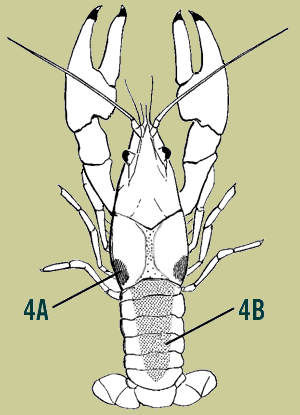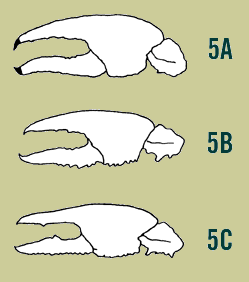 rusty
crayfish factsheet
rusty
crayfish factsheet
by Jeffrey Gunderson
Identifying crayfish can be very difficult. Positive identification
requires looking at a number of characteristics and having enough experience to
interpret them. Here are some general, easily-observed characteristics that can
be used to help you identify mature adults of four common crayfish species found
in the Great Lakes region. (Other species found in the region include Cambarus
diogenes, Procambarus acutus acutus, and in southern parts of the region Procambarus
clarki). The following are general identification guidelines and should not
be used when positive identification is needed. Contact your local fishery management
agency or Minnesota Sea Grant if positive
identification is required.
4A:
Composite drawing of O. rusticus and O. propinquus. dark
spot on carapace of O. rusticus. 4B: dark patch and appearance of
light colored stripeon abdomen of O. propinquus. Rusty
crayfish can generally be identified by their more robust claws, which are larger
than either O. immunis' or O. virilis', and by the dark, rusty spots
on each side of their carapace. The spots are located on the carapace as though
you picked up the crayfish with paint on your forefinger and thumb (Figure 4A).
The spots may not always be present or well developed on rusty crayfish from some
waters. O. propinquus has a claw very similar to the rusty crayfish,
but lacks the dark spots on each side of the carapace. Instead, O. propinquus
has a dark brown to black patch on the top of the abdomen ("tail section"). This
gives the impression that a light-colored stripe runs along each side of the abdomen
(Figure 4B). Compared to the rusty crayfish, O. virilis can often be
distinguished by its claws, which are more blue and have distinct white, wart-like
bumps. The rusty claw, by comparison, is grayish-green to reddish-brown and is
smoother (Figure 5). 5A: O.
rusticus-O. propinquus 5B: O. virilis 5C:
O. immunis
IDENTIFICATION
 Claw shape can help distinguish between the various species.
Claw shape can help distinguish between the various species.
Black bands at claw tips. Oval gap when closed.
Smooth, S-shaped, moveable claw.
No black
bands. Gap is a mere slit when claw is closed. White wart-like bumps on claw.
No black bands. Gap is a definite notch. Claws are narrower
and elongate.
| minnesota sea grant |